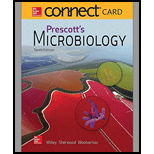
Concept explainers
How might you attempt to grow in the laboratory a chemolithoautotroph that uses ferrous iron as an electron donor and oxygen as an electron acceptor?
The culture media may be complex, defined, supportive, enriched, selective, and differential. The culture media possess the same qualities that are needed by the microbes as if they grow in their natural habitat. The culture media can be modified according to the nutritional needs of the microbes.
Explanation of Solution
Some of the organism can effectively trap the energy in the form of inorganic chemicals are known as chemolithoautotrophs. Most of the inorganic compounds are iron, ammonia, and hydrogen sulfide. The chemolithoautotrophs effectively converse energy, uses the inorganic compounds that are released as waste by the chemoorganoheterotrophs oxidize to release ATP.
To grow a chemolithoautotroph in the lab with oxygen as the electron acceptor and ferrous iron as the electron donor one should incubate the organism in the presence of carbonate, oxygen, FeSO4 at acidic pH. The absence of oxygenic conditions selects against anaerobes and absence of organic carbon selects against the heterotrophs. The growth of phototrophs is simply prevented by incubating cultures in the dark. Candidate strains isolation is prevented by performing plating directly an environmental sample into the designed solid medium or by plating and isolation of the colony.
Want to see more full solutions like this?
Chapter 29 Solutions
Connect Access Card for Microbiology
- What would life be like for photoautotrophs if there were no chemoheterotrophs if there were no photoautotrophs?arrow_forwardWhat is the energy source and carbon source for each of the following: Photoheterotroph, Chemoheterotroph, and Chemoautotroph.arrow_forwardL How can you recognize an enzyme that does not displayMichaelis–Menten kinetics?arrow_forward
- How might the temperature and pH tolerance of ahyperthermophile living in a solfatara differ from that of ahyperthermophile living in a hydrothermal vent?arrow_forwardWhat is meant by the term “chemolithotrophy”? In what wayare chemolithotrophs like plants?arrow_forwardAn unknown microbe is found to be able to photosynthesize, but is also able to fix pyruvate for carbon. What is the best description of this organism? a. photoautotroph b. photochemotroph c. photoheterotroph d. chemoheterotropharrow_forward
- How can organisms such as Syntrophobacter andSyntrophomonas grow when their metabolism is basedon thermodynamically unfavorable reactions? How doescoculture of these syntrophs with certain other bacteriaallow them to grow?arrow_forwardArchae are the source of many enzymes used for biocatalysis in diverse industries such as food and feed, pharmaceuticals, detergent, and beverage industries. These enzymes have unique structural and functional properties that enable use under extreme conditions. Use: https://biolres.biomedcentral.com/articles/10.1186/s40659-018-0186-3 for supplemental info What are three classes of extremophiles and their unique growth characteristics? Based on these characteristics, where are they typically found? The functional properties are linked to protein structural characteristics that imparts unique functional properties. For alkaliphiles and thermophiles, what structural elements (or characteristics) within the enzyme structure create these unique properties? See Table 2. Briefly discuss how the unique properties of these enzymes may be beneficial to the design of bioseparation processes. To recover intracellular enzymes, the Archae need to be lysed. Based on their structures,…arrow_forwardWhat type(s) of extremophiles are used in oil well drilling operationsarrow_forward
 Human Anatomy & Physiology (11th Edition)BiologyISBN:9780134580999Author:Elaine N. Marieb, Katja N. HoehnPublisher:PEARSON
Human Anatomy & Physiology (11th Edition)BiologyISBN:9780134580999Author:Elaine N. Marieb, Katja N. HoehnPublisher:PEARSON Biology 2eBiologyISBN:9781947172517Author:Matthew Douglas, Jung Choi, Mary Ann ClarkPublisher:OpenStax
Biology 2eBiologyISBN:9781947172517Author:Matthew Douglas, Jung Choi, Mary Ann ClarkPublisher:OpenStax Anatomy & PhysiologyBiologyISBN:9781259398629Author:McKinley, Michael P., O'loughlin, Valerie Dean, Bidle, Theresa StouterPublisher:Mcgraw Hill Education,
Anatomy & PhysiologyBiologyISBN:9781259398629Author:McKinley, Michael P., O'loughlin, Valerie Dean, Bidle, Theresa StouterPublisher:Mcgraw Hill Education, Molecular Biology of the Cell (Sixth Edition)BiologyISBN:9780815344322Author:Bruce Alberts, Alexander D. Johnson, Julian Lewis, David Morgan, Martin Raff, Keith Roberts, Peter WalterPublisher:W. W. Norton & Company
Molecular Biology of the Cell (Sixth Edition)BiologyISBN:9780815344322Author:Bruce Alberts, Alexander D. Johnson, Julian Lewis, David Morgan, Martin Raff, Keith Roberts, Peter WalterPublisher:W. W. Norton & Company Laboratory Manual For Human Anatomy & PhysiologyBiologyISBN:9781260159363Author:Martin, Terry R., Prentice-craver, CynthiaPublisher:McGraw-Hill Publishing Co.
Laboratory Manual For Human Anatomy & PhysiologyBiologyISBN:9781260159363Author:Martin, Terry R., Prentice-craver, CynthiaPublisher:McGraw-Hill Publishing Co. Inquiry Into Life (16th Edition)BiologyISBN:9781260231700Author:Sylvia S. Mader, Michael WindelspechtPublisher:McGraw Hill Education
Inquiry Into Life (16th Edition)BiologyISBN:9781260231700Author:Sylvia S. Mader, Michael WindelspechtPublisher:McGraw Hill Education





